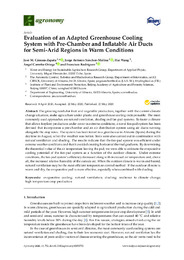Please use this identifier to cite or link to this item:
https://hdl.handle.net/11000/33489Full metadata record
| DC Field | Value | Language |
|---|---|---|
| dc.contributor.author | Cámara-Zapata, José-María | - |
| dc.contributor.author | Sanchez-Molina, Jorge Antonio | - |
| dc.contributor.author | Wang, Hui | - |
| dc.contributor.author | Carreño Ortega, Angel | - |
| dc.contributor.author | Rodríguez-Díaz, Francisco | - |
| dc.contributor.other | Departamentos de la UMH::Física Aplicada | es_ES |
| dc.date.accessioned | 2024-10-14T12:02:51Z | - |
| dc.date.available | 2024-10-14T12:02:51Z | - |
| dc.date.created | 2020-05 | - |
| dc.identifier.citation | Agronomy 2020, 10, 752 | es_ES |
| dc.identifier.issn | 2073-4395 | - |
| dc.identifier.uri | https://hdl.handle.net/11000/33489 | - |
| dc.description.abstract | The growing needs for fruit and vegetable production, together with the current climate change situation, make agriculture under plastic and greenhouse cooling indispensable. The most commonly used approaches are natural ventilation, shading and fan-pad systems. To foster a climate that allows forplant production under cover in extreme conditions, a novel fan-pad system has been devised that incorporates a pre-chamber and an air distribution system using air ducts running alongside the crop rows. The system has been tested in a greenhouse in Almeria (Spain) during the daytime in August, when the weather was hotter. Tests were also carried out in combination with natural ventilation and shading. The results indicate that the fan-pad system was efficient under extreme weather conditions and that it avoided creating horizontal thermal gradients. By determining the theoretical value of the air temperature leaving the pad, we were able to estimate the evaporative cooling potential of the fan-pad system as a function of the outdoor climate. Under extreme conditions, the fan-pad system’s efficiency decreased along with increased air temperature and, above all, the increased relative humidity of the outside air. When the outdoor climate is warm and humid, natural ventilation may be the most efficient temperature control method. If the outdoor climate is warm and dry, the evaporative pad is more effective, especially when combined with shading. | es_ES |
| dc.format | application/pdf | es_ES |
| dc.format.extent | 20 | es_ES |
| dc.language.iso | eng | es_ES |
| dc.publisher | MDPI | es_ES |
| dc.rights | info:eu-repo/semantics/openAccess | es_ES |
| dc.rights | Attribution-NonCommercial-NoDerivatives 4.0 Internacional | * |
| dc.rights.uri | http://creativecommons.org/licenses/by-nc-nd/4.0/ | * |
| dc.subject | Evaporative cooling | es_ES |
| dc.subject | Natural ventilation | es_ES |
| dc.subject | Shading | es_ES |
| dc.subject | Resilience to climate change | es_ES |
| dc.subject | High temperature crop production | es_ES |
| dc.title | Evaluation of an Adapted Greenhouse Cooling System with Pre-Chamber and Inflatable Air Ducts for Semi-Arid Regions in Warm Conditions | es_ES |
| dc.type | info:eu-repo/semantics/article | es_ES |
| dc.relation.publisherversion | https://doi.org/10.3390/agronomy10050752 | es_ES |

View/Open:
agronomy-10-00752-v2.pdf
5,22 MB
Adobe PDF
Share:
.png)
